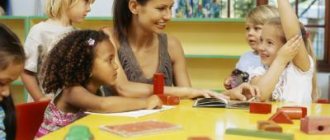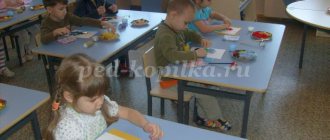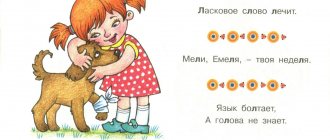Physical development
In children four and five years of age, coordination of movements significantly improves. They are more dexterous and skillful compared to two-year-olds or three-year-olds. During this period, muscles are actively strengthened.
Physical activity is very important. But the load needs to be dosed, since the muscles develop unevenly.
A four-year-old child can already be enrolled in a sports section (gymnastics, swimming, football).
Workouts should not exceed 45-60 minutes. 2 classes per week are optimal. They help discipline the child and allow them to splash out accumulated energy.
In the fifth year of life, the child grows 5-7 centimeters. Weight increases on average by 1.5 - 2.5 kilograms.
Psychological development
Four years of age is a period of calm; the crisis of three years has passed. Children are calmer and easier to negotiate with. Tantrums don't happen often. They are caused by overwork or stressful situations.
At this age, it is important for a child to communicate with peers. Children develop a need for friends. Interest in the world around us is growing significantly.
During this period, mental processes (memory, attention, etc.) become more conscious. The will and desire to achieve results develop.
The type of thinking of four-year-old children is visual-figurative. Their actions are aimed at gaining experience.
The child's memory is getting better. A four-year-old can learn a long poem. Children confidently retell their favorite fairy tales and stories.
Middle preschoolers are good at maintaining attention. They are able to engage in one type of activity (drawing, modeling, working with tests) for 15-20 minutes without distraction.
At the age of 4-5 years, the child exhibits:
- Independence. Children are able to take care of themselves well and need less and less parental care. They persistently declare their rights and try to establish their own rules. But at the same time, they are ready for dialogue and make compromises.
- Fears. Developed imagination makes children's games more and more complex. The other side of the coin is fear. They are normal for this age and form part of mental development. Partly, fears are a consequence of a feeling of insecurity in a large and not fully understood world.
- Ideas about ethics. The child develops an idea of ethics and standards of behavior. But they are based not on the words of adults, but on their actions. It is important for parents to ensure that actions do not contradict words.
- Creative skills. A developed imagination allows kids to create their own worlds on paper. Drawing classes on a free theme for four-year-old children are very important.
- Active knowledge of the world. Children are interested in everything, they constantly ask questions and demand clarification. They are ready to offer their own answers and are capable of logical reasoning. They love to discuss the events of the day, the plots of cartoons.
age characteristics of children 4-5 years old article (middle group) on the topic
Age characteristics of middle group children (4-5 years old)
The ages of four to five years are the middle preschool period. It is a very important stage in a child's life. This is a period of intensive development and growth of the child’s body. At this stage, the child’s character changes significantly, and cognitive and communication abilities are actively improved. There are specific age characteristics of children 4–5 years old according to the Federal State Educational Standard, which parents simply need to know so that the development and upbringing of a preschooler is harmonious. This means that as the child grows older, he will always find a common language with his peers.
The child’s physical capabilities increase significantly: coordination improves, movements become more confident. At the same time, the constant need to move remains. Motor skills are actively developing; in general, the average preschooler becomes more dexterous and faster than younger ones. It should be noted that the age characteristics of children 4–5 years old are such that physical activity needs to be dosed so that it is not excessive. This is due to the fact that muscles during this period grow, although quickly, but unevenly, so the child gets tired quickly. Therefore, babies need to be given time to rest. As for the pace of physical development, from 4 to 6 years they do not change significantly. On average, a child grows 5–7 cm per year and gains 1.5–2 kg of weight. All organs and systems of the child’s body grow and develop.
Mental development of a child at the age of 4–5 years, various mental processes quickly develop: memory, attention, perception and others. An important feature is that they become more conscious and voluntary: volitional qualities develop, which will definitely be useful in the future. 5 things you shouldn't feel ashamed about. The type of thinking characteristic of a child now is visual-figurative. This means that most of the children’s actions are of a practical, experimental nature. Visibility is very important to them. However, as they grow older, thinking becomes generalized and by older preschool age it gradually turns into verbal-logical thinking. The volume of memory increases significantly: he is already able to remember a short poem or an instruction from an adult. Voluntariness and stability of attention increase: preschoolers can concentrate on any type of activity for a short time (15–20 minutes). Taking into account the above-mentioned age characteristics of children 4–5 years old, preschool teachers create conditions for productive work and harmonious development of the child.
The role of play: Playing activity still remains the main one for the baby, but it becomes significantly more complicated compared to an early age. The number of children participating in communication is increasing. Thematic role-playing games appear. The age characteristics of children 4–5 years old are such that they are more inclined to communicate with peers of the same sex. Girls prefer family and everyday topics (mothers and daughters, shopping). Boys prefer to play sailors, military men, and knights. At this stage, children begin to organize their first competitions and strive to succeed.
Creative abilities: Middle preschoolers enjoy mastering various types of creative activities. The child likes to do plot modeling and appliqué. One of the main ones is visual activity. The age characteristics of children 4–5 years old according to the Federal State Educational Standard suggest that at this stage the preschooler has already mastered fine motor skills, which allows him to draw in detail and pay more attention to details. Drawing becomes one of the means of creative self-expression. The average preschooler can compose a short fairy tale or song, understands what rhymes are and uses them. Vivid imagination and rich imagination allow you to create entire universes in your head or on a blank sheet of paper, where a child can choose any role for himself.
Speech development: During the middle preschool period, active development of speech abilities occurs. Sound pronunciation improves significantly, vocabulary actively grows, reaching approximately two thousand words or more. Speech age characteristics of children 4–5 years old allow them to more clearly express their thoughts and fully communicate with peers. The child is already able to characterize this or that object, describe his emotions, retell a short literary text, and answer an adult’s questions. At this stage of development, children master the grammatical structure of the language: they understand and correctly use prepositions, learn to construct complex sentences, and so on. Coherent speech develops. Communication with peers and adults In middle preschool age, contacts with peers become of paramount importance. If previously a child had enough toys and communication with his parents, now he needs interaction with other children. There is an increased need for recognition and respect from peers. Communication, as a rule, is closely related to other types of activities (games, joint work). The first friends appear with whom the child communicates most willingly. Competition and the first leaders begin to emerge in the group of children. Communication with peers is, as a rule, situational in nature. Interaction with adults, on the contrary, goes beyond the specific situation and becomes more abstract. The child regards his parents as an inexhaustible and authoritative source of new information, and therefore asks them many different questions. It is during this period that preschoolers experience a special need for encouragement and are offended by comments and if their efforts go unnoticed. Sometimes adult family members do not notice these age-related characteristics of children 4–5 years old.
Emotional characteristics: At this age, significant development of the sphere of emotions occurs. This is the time of first sympathies and affections, deeper and more meaningful feelings. A child can understand the mental state of an adult close to him and learns to empathize. Children are very emotional about both praise and comments; they become very sensitive and vulnerable. By the age of 5, a child begins to be interested in issues of sex and his or her gender identity. As already mentioned, one of the distinctive features of this age is vivid fantasy and imagination. It must be borne in mind that this can give rise to a variety of fears. A child may be afraid of a fairy tale character or imaginary monsters. Parents do not need to worry too much: this is not a problem, but only the age characteristics of children 4–5 years old. Psychology knows many ways to combat such fears, but it is important to remember that these are just temporary difficulties that will go away over time if parents do not focus on them or use them against the child for educational purposes. Teaching children 4–5 years old When teaching, employees of preschool institutions take into account the psychological and age characteristics of children 4–5 years old. According to the program “From birth to school”, currently used, the emphasis is on the formation and comprehensive development of the individual. At the same time, thematic classes are held with children, which explain the rules of behavior in a team, at home and in public places, the basics of safety, speech development, hygiene skills are improved, and so on. At the same time, the educational process is based on the game. Teachers introduce the child to new concepts and rules through an accessible and attractive activity, taking into account the age characteristics of children 4–5 years old. At this age, it is necessary to expand the child’s horizons and his knowledge about the world around him.
Education: When talking about raising children of this age, you need to remember that at this stage the character changes significantly. The crisis of three years passes safely, and the child becomes much more obedient and flexible than before. It is at this time that children need full communication with their parents. The main function of adults now is to explain in as much detail as possible and show by personal example. The child absorbs everything like a sponge, reaching out to new knowledge with the curiosity of a discoverer. Parents must listen carefully to numerous questions and answer them, because in the family children gain their first knowledge about the world around them and their place in it. It is now that it is necessary to lay down moral qualities, to develop kindness, politeness, responsiveness, responsibility, and love of work in a child. At this stage, the child makes his first friends, so it is very important to teach how to communicate with peers: to give in, to defend one’s interests, to share.
The role of preschool institutions: It is worth noting that the best success in education can be achieved in the case of close and trusting cooperation between the family and the preschool institution, since kindergarten staff take into account the age characteristics of children 4–5 years old. Consultation for parents is one way of such interaction. Adult family members should have at least minimal training in psychology in order to better understand their child. Another way to characterize the age characteristics of children 4–5 years old is a parent meeting. Here, educators and a child psychologist, together with adult family members, can outline the basic principles of education and discuss all interesting and controversial issues.
Family is the most important. According to practicing child psychologists, the family plays a vital role in the development of a child’s personality. The relationship between parents is the first thing a growing child sees; this is the standard that he considers the only true one. Therefore, it is very important that the child has a worthy example in the person of adults. Parents should remember that it is in preschool age that character traits such as kindness, justice, truthfulness develop, and life values and ideals are laid. Therefore, it is so important to take into account the age characteristics of children 4–5 years old. Assistance in developing individual character traits should also be provided in accordance with the gender of the preschooler and the roles of adults in the family. So, the mother teaches the child to find a common language, to seek a compromise, affection, care and love emanate from her. The father is the personification of order, protection, he is the first teacher of life who helps to be strong and purposeful. Relationships within the family are the most important factor influencing the upbringing of a child and his entire subsequent life.
Interaction with peers and adults
Children need communication, they seek it. Games with peers are becoming more and more difficult. Children act out various scenes: everyday ones (hospital, lesson at school, daughters and mothers), fairy tales. Ideas for the latter are drawn from favorite works and cartoons, but they are transformed by the child’s imagination.
Communication between children is becoming more and more like adult relationships. The kids are offended, jealous, and help each other. One four-year-old can support and reassure another.
At this age, the baby develops a need for approval and respect from peers. Sometimes their opinion becomes on the same level as their parents'.
At 4-5 years old, we can safely say that the child has friends, and not “neighbors” in the game.
It is important that the child is in the company of peers: attends a kindergarten, a class, plays on the playground with other kids. Try to satisfy his need for communication.
Tips for parents
Taking into account all the above-mentioned features of the development of a 4-5 year old child, parents will be able to get the maximum benefit from them in order to raise a full-fledged personality and qualitatively prepare the child for school. Psychologists and teachers advise building a relationship with your baby in the following way at this age.
- There should not be too many prohibitions, rules and laws: due to his mental age characteristics, the child will not be able to comply with them all. On the contrary, if there is an exorbitant number of them, get ready for war: the baby will stage a protest.
- React with restraint to the child’s justified insult and anger.
- Tell him about your feelings and experiences. This way he will better understand you and the people around you.
- Discuss with him the features and details of any difficult ethical situations in which he finds himself in the yard and in kindergarten.
- Don't overload his conscience. There is no need to constantly tell him about his mistakes: a destructive feeling of guilt, fear, vindictiveness, and passivity will appear.
- A 4-5 year old child does not need to be told scary stories, shown horror films, or talk about death and illness.
- Be interested in your baby's creative abilities and successes. But don't criticize.
- Allow him to play with his peers as much as possible.
- Answer any questions, ask for his opinion. Tell me how to independently search for information.
- Play with him at home.
- Read books.
- Reinforce any knowledge you gain.
Those parents who care about the development of a full-fledged personality of the child should keep in mind all of the above-mentioned age-related features of the development of children 4-5 years old: they are a guideline. Knowing about them, it is much easier to guide the child in the right direction, understand his inner world, and help him cope with the difficulties that this period is fraught with. Such a policy will make it possible to qualitatively prepare a preschooler for his upcoming studies at school and facilitate social adaptation.
Four-year-old physical skills
Physical performance only partially depends on parents; children learn a lot from each other.
So, what should a child of 4-5 years old be able to do:
- maintain balance when running fast, easily change the trajectory of movement;
- jump on one leg;
- stand in the heron pose for up to 10 seconds;
- move forward by jumping on two legs;
- ride a three- or four-wheeled bicycle;
- crawl under not very tall objects;
- jump high and long.
Mental skills of a child at 4-5 years old
Indicators of mental development largely depend on what the parents have already taught the child. Norms only show potential opportunities and set the vector of learning.
Don't be upset if you missed something, now is the best time to catch up.
Ideas about mathematics
The child must be good at identifying the location of objects: left, right, above, below, behind, in front. He knows basic geometric shapes. The baby confidently counts to 10. He knows the numbers from 1 to 5 and finds them in the picture.
Children have an understanding of the concepts of “one - many”, “more - less”. Able to arrange objects from smallest to largest and vice versa.
The baby easily compares two or three objects. He is able to describe their shape and size.
The easiest way to fill knowledge gaps is through educational games and creative activities. You can improve your score by playing in the store. Let the baby pay for toys, groceries, or play the role of a salesman and count out the change.
To reinforce concepts about sizes and geometric shapes, use visual material. Play school, where first the child is the teacher and gives you a task, and then the student. Mini-competitions to see who can sort from large to small the fastest, and the like, are also suitable for this purpose.
Logics
Children aged 4-5 years are good at generalizing. They call groups of objects in one word: furniture (bed, sofa, wardrobe, etc.), toys, dishes. They understand the concepts of domestic animals, wild animals, plants and trees.
Kids have an idea of the seasons. They are able to describe how one is different from another. The child can tell what they play, for example, in winter, how they dress. He is able to explain why you can’t skate in the summer and why you can’t sunbathe or swim in the winter.
Children willingly put together large puzzles of 8-10 pieces. They can assemble the picture shown in the instructions from a construction set or mosaic.
The child can combine words into pairs based on attributes. For example, a plate is soup, a chamomile is a meadow. He can find “artist errors” in the picture, differences between two almost similar images.
To develop logic, attention, and memory, they use tasks for preschoolers from special educational notebooks and cards for preparing for school.
Parents can play with their baby by asking them to take turns naming trees, pets or birds, or flowers. In addition, it will develop your understanding of the world around you.
Logical tasks for children 4-5 years old can be like this:
- Let's pretend it's winter. What will you wear for a walk? What will we play outside?
- Invite your child to write a story about his morning. What does he do first (wakes up, washes himself), what then (exercises, breakfast, going to the garden).
- Using thematic pictures, invite your child to determine the order of actions. For example, a bird made a nest, laid eggs, hatched them, and the chicks hatched. Before class, the pictures are mixed.
Speech skills
The child’s speech should be clear and understandable to outsiders, and not just to the inner circle. It is not considered a deviation if the baby does not pronounce hissing or sonorous sounds.
Four-year-old children correctly use prepositions, cases, and declensions in speech. They can divide simple words into syllables. Some at this age are able to remember the entire alphabet, find and name the letters in the picture.
Children support the conversation well, give complete answers to questions, and ask them themselves.
Educational games for children on speech development are aimed at enriching vocabulary and developing retelling skills. Invite your child to make up a story based on the picture and describe what is happening.
Discuss with your child a fairy tale you read or a cartoon you watched. Encourage him to express his opinion by constructing complex sentences.
It will help in the development of speech and prepare the hand for writing. Graphomotor pictures, shading and drawing simple elements in cells can captivate a child for 5-15 minutes.
Logic, mathematical abilities
Age-related curiosity and the desire to show the degree of one’s “maturity” at this stage of growth and development, together with the improvement of brain development processes, cannot but affect the level of intelligence in general and the expansion of the palette of logical and mathematical skills in particular. Now the memory capacity is rapidly increasing, attention is able to concentrate for a longer time. This is the period when a wide variety of knowledge can be imbued into the memory of a preschooler, which will be useful to him in the future.
The thinking of a child of this age is visual and figurative, and visibility still comes first, so his actions, including mental ones, are of a practical nature. Only by the end of the fifth year will thinking gradually turn into verbal-logical, built on logical reasoning. The child will master complex mental operations of generalization, comparison, analysis, synthesis, classification, and will be able to draw logical conclusions. This will speak not only about the level of general development, but also about the degree of readiness of the child for school.
Now there is active preparation for the transition to a new type of thinking. A child of this age already knows and can:
- navigates the location of objects (front, back, middle, top, bottom);
- knows basic geometric shapes (triangle, circle, square, oval, rectangle);
- counts up to 9, matching the number of objects with a specific number;
- can arrange numbers from 1 to 5 in direct and reverse order;
- when comparing objects, understands the concepts “less”, “equally” (“equal”), “more”;
- can find similarities and differences in an image;
- folds a picture cut into 2–6 parts;
- assembles according to a design model without outside help (complex pyramid shape, figures from a construction set);
- inserts the missing fragments of the image (puzzle);
- finds pairs of objects, an extra object in the chain, can explain his decision;
- selects opposite words, understanding their meaning;
- can explain the discrepancy between the picture and reality, find unnecessary details;
- is able to assemble letters into syllables - you can begin learning to read.







